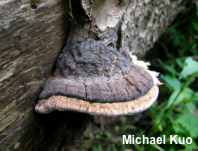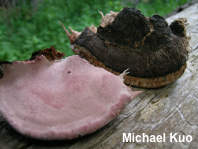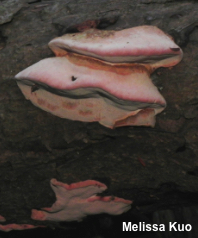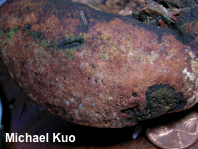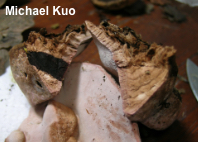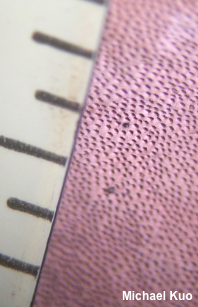| Major Groups > Polypores > Rhodofomes roseus |

|
Rhodofomes roseus [ Basidiomycota > Polyporales > Fomitopsidaceae > Rhodofomes . . . ] by Michael Kuo The deep pink pore surface of this tough perennial mushroom is a pleasant surprise—and proof that you can't always judge a polypore by its cover! Rhodofomes roseus is very similar to Rhodofomes cajanderi, but can usually be distinguished on the basis of its more clearly defined, convex to hoof-shaped caps (the caps of Rhodofomes cajanderi tend to be fused and relatively flat). Microscopic features also separate the two species; Rhodofomes cajanderi has curved spores, and cystidioles. Finally, in many areas (the Rocky Mountains, the West Coast, the Alps), Rhodofomes roseus is more likely to appear on the wood of spruce, at higher elevations, while Rhodofomes cajanderi is more likely on the wood of Douglas-fir or pines, at lower elevations—but this is not always the case. Fomitopsis rosea is a synonym. Description: Ecology: Saprobic on the deadwood of conifers (and, rarely, hardwoods); also sometimes parasitic on living trees; causing a brown cubical rot; growing alone or gregariously; perennial; originally described from Germany; widely distributed in Europe; in North America distributed from Canada through Mexico, especially in northern and montane (including Appalachian) areas; reported from the Caribbean and Central America, as well as Asia and Oceania. The illustrated and described collections are from Colorado and Ohio. Cap: 5–10 cm across; 3–8 cm deep; convex or broadly convex, becoming hoof-shaped; fairly bald, but rugged, developing cracks and fissures with age; pink to brownish pink when young, becoming brown to dark brown or nearly black; often zoned. Pore Surface: Pink; bruising darker pink, then slowly brownish; with 3–8 round pores per mm; annual tube layers up to 8 mm deep. Stem: Absent. Flesh: Pinkish or, in age, brownish; unchanging when sliced; faintly zoned; leathery to woody. Odor: Fragrant. Chemical Reactions: KOH instantly black on flesh. Microscopic Features: Spores 6–8 x 2–3 µm; subcylindric; smooth; hyaline in KOH; inamyloid. Basidia 10–18 x 4–6 µm; clavate; 4-sterigmate. Cystidioles not found. Hyphal system trimitic, with thin-walled clamped generative hyphae; thick-walled non-septate skeletal hyphae, and branching, thick-walled, non-septate binding hyphae. REFERENCES: (J. B. von Albertini & L. D. von Schweinitz, 1805) F. Kotlaba & Z. Pouzar, 1990. (Fries, 1821; Overholts, 1953; Smith, Smith & Weber, 1981; Breitenbach & Kränzlin, 1986; Carranza-Morse & Gilbertson, 1986; Gilbertson & Ryvarden, 1986; McNeil, 2006; Kim et al., 2007; Ortiz-Santana et al., 2013; Han et al., 2016; Ginns et al., 2017; Justo et al., 2017; Læssøe & Petersen, 2019.) Herb. Kuo 08130803, 07291206. This site contains no information about the edibility or toxicity of mushrooms. |
© MushroomExpert.Com |
|
Cite this page as: Kuo, M. (2022, July). Rhodofomes roseus. Retrieved from the MushroomExpert.Com Web site: http://www.mushroomexpert.com/rhodofomes_roseus.html |
